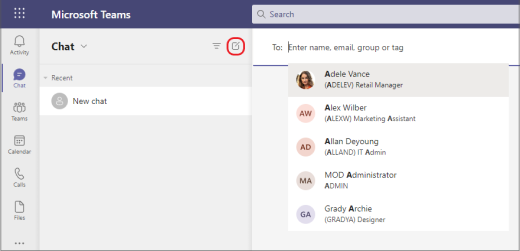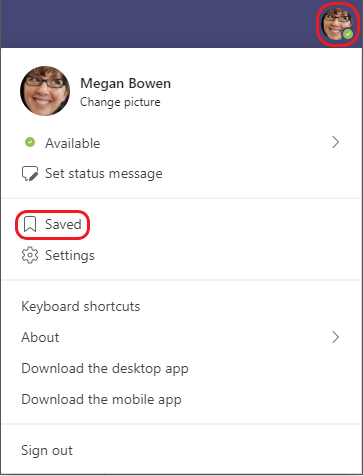 277
277
First things to know about chats in Microsoft Teams
Chat is at the center of everything you do in Microsoft Teams. From individual chats with just one other person, to group chats and conversations in channels—chat has you covered.
The following are the first things to know:
1. Chats can be one-on-one or in a group
Sometimes, you’ll want to talk one-on-one with someone. Other times, you’ll want to have a small group chat. In Chat, you can do either.
You start one-on-one and group chats the same way: by selecting New chat  at the top of your chat list. Once in a chat, you’ll be able to send messages that include files, links, emoji, stickers, and GIFs—whatever you need to get your point across.
at the top of your chat list. Once in a chat, you’ll be able to send messages that include files, links, emoji, stickers, and GIFs—whatever you need to get your point across.

The following are more details about each kind of chat:
One-on-one chat
Once you’ve selected New chat  and entered the person’s name, compose your message in the text box and then select Send
and entered the person’s name, compose your message in the text box and then select Send  or press Enter. This starts the chat.
or press Enter. This starts the chat.

Chat with yourself
For times when you want to draft messages, send files from one device to another, or get to know features a little better, you can start a chat with yourself. Everything you do in a regular chat you can also do in a chat with yourself. You’ll see it pinned to the top of your chat list by default.
If you unpin the chat with yourself and want to find it again, select New chat  and enter your name into the To field.
and enter your name into the To field.

Group chat
Use a group chat when you need to talk to a small group of people. Start one the same way you start a one-on-one chat: select New chat  at the top of your chat list. Select the down arrow to the far right of the To field and type a name for the chat in the Group name field. Next, type the names of the people you’d like to add in the To field.
at the top of your chat list. Select the down arrow to the far right of the To field and type a name for the chat in the Group name field. Next, type the names of the people you’d like to add in the To field.

Once the chat has begun (whether group or one-on-one), just choose it in the chat list to resume the conversation and send more messages.

2. Press Shift+Enter to start a new line
If you keep pressing Enter to start a new line, which sends the message before you’re ready, try the following:
When you want to start a new paragraph, press Shift+Enter to insert the line break. If you’ve opened your formatting options (see step 3 for details), just press Enter to start a new line of text, then select Send  to send it.
to send it.

3. Select Format to see all your formatting options
There are many formatting options for messages.
To open your formatting options, select Format  beneath the box where you type your message. In this expanded view, select the text that you want to format, then choose an option like B, I, or U to bold, italicize, or underline the text. There are also options for highlighting, font size, font color, lists, and more.
beneath the box where you type your message. In this expanded view, select the text that you want to format, then choose an option like B, I, or U to bold, italicize, or underline the text. There are also options for highlighting, font size, font color, lists, and more.

Beneath the box you'll also find delivery options, attach files, emoji, giphy, stickers, schedule a meeting, and more. Select More options  to find more apps.
to find more apps.
4. Chat happens in channels, too
When you go to any channel in Teams the very first tab is Posts. Think of this as one big group chat. Everyone who has access to the channel can see messages in Posts.

Based on your organization and culture, you'll need to decide which messages are suitable for the Posts tab in a particular channel.
Another important thing to know is that replies to a channel message stay attached to the original message. This way, the whole thread of the conversation can be easily followed by anyone reading it. This is what's great about threaded conversations.
To reply to a channel message, be sure to use the Reply link underneath the message.

5. There are several ways to search for and find messages
Depending on what you remember about the sender of the message or the characteristics of the message, a different way of searching might make more sense.
Find a chat based on a person’s name
Enter the person’s name in the command box at the top of Teams. You’ll see their name and any group chats they're a part of with you listed. Select their name to go to your one-on-one chat with them or select a group chat to resume that one.

Find a message that has a keyword that you remember
Start typing a keyword into the command box at the top of Teams and press Enter. You’ll see a list of results that include the keyword.
Filter to show certain types of messages
From the Activity feed, select Filter  and then More options
and then More options  to show certain types of messages including unread messages, @mentions, replies, and reactions.
to show certain types of messages including unread messages, @mentions, replies, and reactions.
For a more specific search, go to the Feed menu, select the drop-down arrow, and then choose My Activity.

Find your saved messages
To save a message, hover over it, select More options  , and then select Save message
, and then select Save message  .
.

To see a list of your saved messages, select your profile picture at the top of Teams, then choose Saved. Or, type /saved in the command box at the top of Teams.

6. Delete, hide, or mute chats to keep them out of your way
You can delete an entire chat conversation, hide the chat from the chat list, or mute it so you stop getting notifications. For details, see Delete a chat thread in Teams and Hide, mute, or pin a chat in Teams.
Note that you are also able to delete individual messages you've sent.
Original Article:




